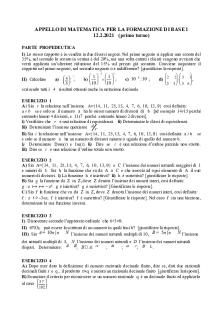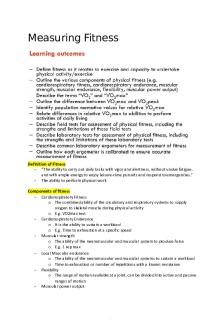2-2 determining g on an incline PDF

| Title | 2-2 determining g on an incline |
|---|---|
| Author | Brian Mu |
| Course | Physics (without Calculus) 1 Lab |
| Institution | Miami Dade College |
| Pages | 12 |
| File Size | 780.9 KB |
| File Type | |
| Total Downloads | 38 |
| Total Views | 148 |
Summary
2-2 determining g on an incline of Algebra-based Physics I Lab...
Description
Determining g on an Incline Lab II
II. Abstract Our objective in this lab was to determine the relationship between the angle of an incline and the acceleration of a cart rolling freely down the incline. We performed this experiment using a motion detector, 3 books, an incline plane, and a cart. To begin the experiment, we placed the incline plane onto the first book and placed the motion detector at the top of the plane. We then began collecting data once we released the cart at the top of the plane and recorded its acceleration. We repeated this process by continuing to add more books, increasing the height of the incline plane and the angle at which the plane made with the horizontal table. The results we recorded are as follows: the average acceleration for the cart at a height of 2.3cm was 0.153 m/s^2; the average acceleration for the cart at a height of 5.3cm was 0.400 m/s^2; and finally the average acceleration for the cart at a height of 8.3cm was 0.643 m/s^2. The possible sources of error in this experiment could be an unknown amount of friction in the system or possibly different initial velocities due to a slight push from the person that let go of the cart.
III. Data Preliminary Questions: Do you think that during Galileo’s day it was possible to get useful data for any of these experiments? Why? I believe that it was not possible to get useful data for any of these experiments in Galileo’s day because there were not accurate or precise measuring tools that far back in time. Acceleration as a Function of Time for Book Height 1 Trial 1:
Trial 2:
Trial 3:
Acceleration as a Function of Time for Book Height 2 Trial 1:
Trial 2:
Trial 3:
Acceleration as a Function of Time for Book Height 3 Trial 1:
Trial 2:
Trial 3:
Data Table: Acceleration Acceleration for Trial 3 for Trial 2 (m/s^2) (m/s^2)
Average Acceleration (m/s^2)
3.396x10^-4 0.152m/s^2
0.154m/s^2
0.154m/s^2
0.153m/s^2
118.2cm
7.826x10^-4 0.400m/s^2
0.402m/s^2
0.397m/s^2
0.400m/s^2
118.2cm
1.225x10^-3 0.641m/s^2
0.643m/s^2
0.644m/s^2
0.643m/s^2
Number Height of Books, h of (cm) Books
Length of Incline, x (cm)
Sin(Ɵ)
1
2.3cm
118.2cm
2
5.3cm
3
8.3cm
Acceleration for Trial 1 (m/s^2)
IV. Analysis 1. Using trigonometry and your values of x and h in the data table, calculate the sine of
the incline angle for each height. Note that x is the hypotenuse of a right triangle. See data table above. 2. Plot a graph of the average acceleration (y-axis) vs. sin( θ ) . Use LabQuest App, Logger
Pro, or graph paper. Carry the horizontal axis out to sin(θ ) = 1 (one) to leave room for extrapolation. 3. Draw a best-fit line by hand or use the proportional fit tool and determine the slope. The slope can be used to determine the acceleration of the cart on an incline of any angle.
Slope = 553.4
4. On the graph, carry the fitted line out to sin( 90°) = 1 on the horizontal axis and read
the value of the acceleration. Acceleration at sin(90°)=1 is 553.36567m/s^2. 5. How well does the extrapolated value agree with the accepted value of free-fall
acceleration (g = 9.8 m/s2 )? This extrapolated value does not agree with the accepted value of free-fall acceleration at all. 6. Discuss the validity of extrapolating the acceleration value to an angle of 90° .
The validity of extrapolating the acceleration value at an angle of 90° is very low because when you extrapolate, you are using an estimation of what the numerical values may be in a certain situation and by estimating, you most likely are not close to the true value....
Similar Free PDFs

2-2 determining g on an incline
- 12 Pages

Lab 4 - Motion on an Incline
- 9 Pages

4U Incline Acceleration
- 4 Pages

9/22 Notes on LECTURE
- 5 Pages

An Essay on Bargaining
- 3 Pages

An Essay on Environmental policy
- 11 Pages

Summary An Essay on Man
- 1 Pages

Assignment 1 - g g
- 3 Pages
Popular Institutions
- Tinajero National High School - Annex
- Politeknik Caltex Riau
- Yokohama City University
- SGT University
- University of Al-Qadisiyah
- Divine Word College of Vigan
- Techniek College Rotterdam
- Universidade de Santiago
- Universiti Teknologi MARA Cawangan Johor Kampus Pasir Gudang
- Poltekkes Kemenkes Yogyakarta
- Baguio City National High School
- Colegio san marcos
- preparatoria uno
- Centro de Bachillerato Tecnológico Industrial y de Servicios No. 107
- Dalian Maritime University
- Quang Trung Secondary School
- Colegio Tecnológico en Informática
- Corporación Regional de Educación Superior
- Grupo CEDVA
- Dar Al Uloom University
- Centro de Estudios Preuniversitarios de la Universidad Nacional de Ingeniería
- 上智大学
- Aakash International School, Nuna Majara
- San Felipe Neri Catholic School
- Kang Chiao International School - New Taipei City
- Misamis Occidental National High School
- Institución Educativa Escuela Normal Juan Ladrilleros
- Kolehiyo ng Pantukan
- Batanes State College
- Instituto Continental
- Sekolah Menengah Kejuruan Kesehatan Kaltara (Tarakan)
- Colegio de La Inmaculada Concepcion - Cebu



![Quantization energy lab report er g g g g g g g g g g g g g g g g g g g g g g]\\](https://pdfedu.com/img/crop/172x258/og2v1qo08824.jpg)



